We Tested 8 Coffee Scales—Here Are The Best Ones for Accurate Brewing
Dotdash Meredith and Yahoo Inc. may earn commission or revenue on some items through the links below.
Offerings from Acaia and OXO took top honors.
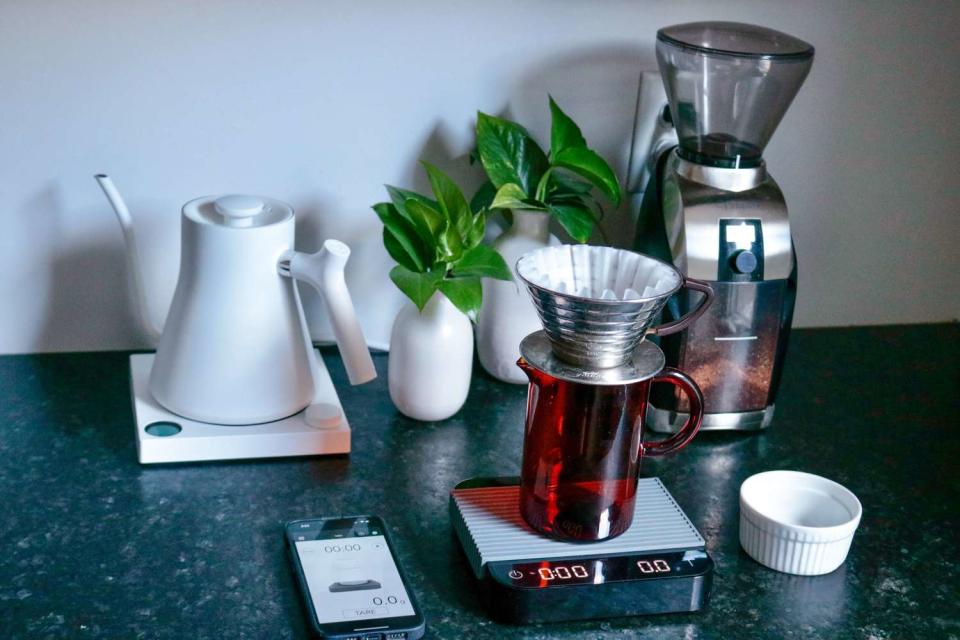
Serious Eats / Jesse Raub
The best coffee scales are fast, responsive, intuitive, and have an easy-to-read interface. They give accurate readings instantly without any measurable delay, showcase a design that is water-resistant, and have a simple timer function that helps make brewing easier. Our favorites were the pricy but stunning Acaia Pearl, and the more affordable, but still solid OXO BREW Precision Coffee Scale with Timer.
For coffee experts, using a scale is not just a suggestion: it’s a requirement. Like baking ingredients, coffee is a tricky one to nail down by volume. Different coffees have varying levels of density due to farming conditions and variety of coffee trees, meaning that standard, two tablespoon coffee scoops of two different coffees from neighboring farms in Colombia could have a 10% variance in weight. That’s important, because coffee brewing is all about extracting a percentage of the mass in order to achieve the sweetest and most balanced flavors.
But coffee scales aren’t just for weighing out the coffee, they’re also essential for measuring the amount of brew water. In the early 2010s, single-cup brewing was becoming increasingly popular in most cafes and coffee bars. And as roasters began to offer more single-origin coffees in their lineup, demand went up. The more coffee bars tried to manage a row of pourover brewers, the more it became clear that it was extremely difficult to manage the consistency of water volume for multiple brews at a time. I experienced this first hand at a downtown Intelligentsia in 2010, when all of the fancy single-cup coffee machines broke down on the same day and we replaced them with 10 Hario V60 pourover brewers. Even though I was elbow-to-elbow with two World Barista Champions, all three of us were in the weeds trying to track how much water we were pouring into each cone.
When the idea to put your entire pourover rig onto a scale surfaced a few months later, it changed coffee brewing. Instead of weighing out coffee on a scale and measuring brew water by volume, you could now immediately track how much water was being added to the coffee in your filter. This created an immediate and accurate coffee-to-water ratio, which allowed for exponentially more accuracy and consistency from cup to cup. Not long after that, the coffee scale was born. In its most simple form, a coffee scale is designed to have a .1 gram resolution matched with a built-in timer, but some models have other features, too.
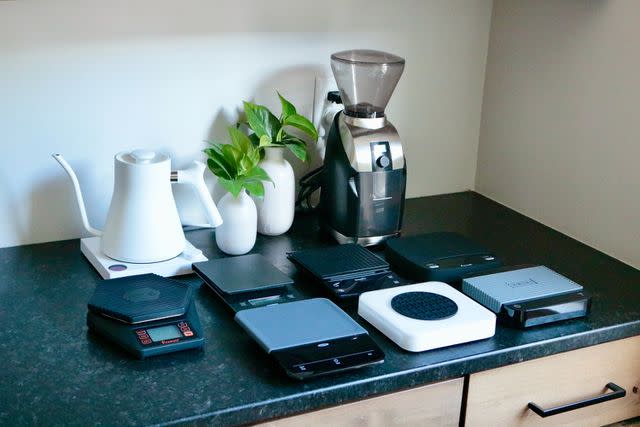
Serious Eats / Jesse Raub
But, why should you buy a coffee scale? I admit that for a lot people a kitchen scale is accurate enough to weigh out coffee. But kitchen scales aren’t up to the task when it comes to measuring out brew water. For starters, a lot of them aren't waterproof and some aren’t designed to withstand the heat of the brewed coffee on the weighing platform. And what's more: coffee scales can feature a flow rate indicator that helps you manage pouring speed and a built-in timer to aid in the whole brewing process. For those who love manual methods, like pourover and French press, these features are all mighty helpful for consistent, accurate brewing.
The Winners, at a Glance
The Best Overall Coffee Scale: Acaia Pearl
Acaia Pearl

The Acaia Pearl is lightning fast, super accurate, and easy to use. On top of that, it also has Bluetooth functionality that expands its user interface, it can be re-calibrated, and it features a flow rate indicator to help people better manage their pouring speed.
The Best Budget-Friendly Coffee Scale: OXO BREW Precision Coffee Scale with Timer
OXO BREW Precision Scale with Timer

The OXO food scale is Serious Eats top pick, and their coffee scale also delivers. With a large, easy-to-read display, simple interface, and accurate readings, the OXO Brew Precision Scale with Timer is well worth its $56 price tag. Out of all the non-Acaia scales tested, it also was the most accurate, yeilding quick readings for each pour.
The Tests
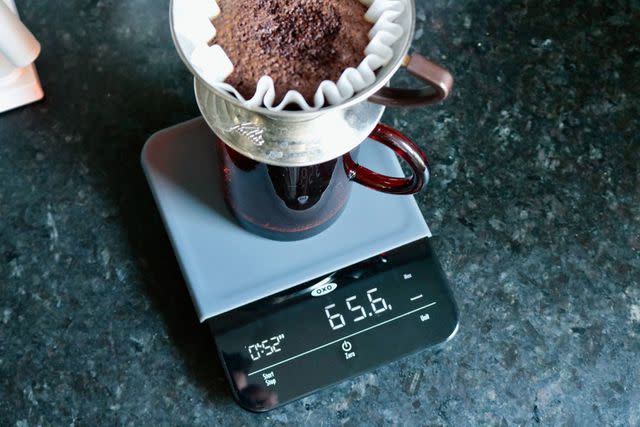
Serious Eats / Jesse Raub
Calibration Test: Each scale was tested with a 100-gram calibration weight to see how accurate it was.
Baseline Accurary Test: I placed a single coffee bean on each scale, to test for accuracy and its ability to register small amounts.
Speed and Accuracy Test: I placed 10 coffee beans onto each scale and timed how long it took it to settle on a final weight. I also noted if this weight was accurate.
Pourover Coffee Test: With each scale, I brewed pourover coffee, following these parameters and evaluating the scale’s ability to read brew water weight quickly and accurately. I also looked at the scale’s control panel: were the buttons responsive and did it manage weight and time simultaneously?
Usability Tests: Throughout testing, I evaluated how easy each scale was to use and how simple its control panel was to read. If the scale had any extra features, like app connectivity and auto-ratio, I assessed those as well.
What We Learned
Most Scales Compensate for Low Weights
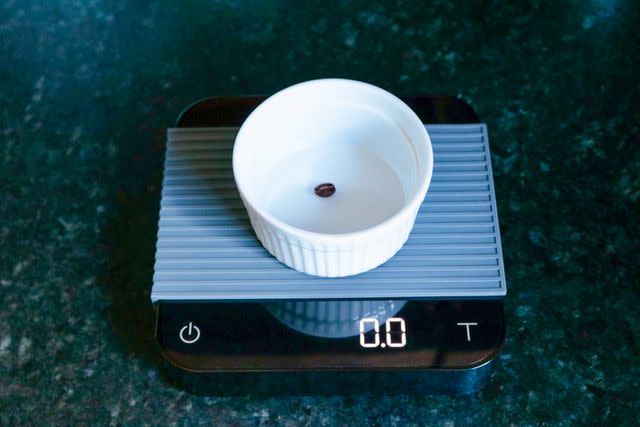
Serious Eats / Jesse Raub
While all of the scales struggled to note the weight of a single coffee bean, we don't really think this would be a common usage.In our first accuracy test, I placed a single coffee bean onto each scale. Our control scale was an Acaia Lunar that had been calibrated with a 100-gram scientific weight and easily displayed that both a single coffee bean from Peru and a single coffee bean from Burundi weighed .2 grams. The Lunar is designed for accuracy (particularly when making espresso) with a smaller weight capacity and a highly responsive platform, but I didn’t expect to see that none of the other scales could even register a single coffee bean being placed onto their platforms. This was tested both with a zeroed out platform and a tared ramekin in order to test responsiveness with added weight, but the only clue as to what might be happening showed up on the Acaia Pearl S: with the Pearl S, the scale would quickly flash to .2 grams, then back to zero. When the coffee bean was removed, the scale would then read -.2 grams, showing that the scale had compensated for the light weight by re-zeroing its platform. Whether that means that the bulk of these scales just weren’t sensitive enough to read .2 grams or that .2 grams is a low enough weight that it’s within the scale’s margin of error, it’s hard to say. This test showed that none of these scales were up to the task for extremely lightweight readings, but I’m not sure many people are trying to weigh a single feather (or in this case, coffee bean) in their kitchen, either.
Design Was the Make-or-Break Feature
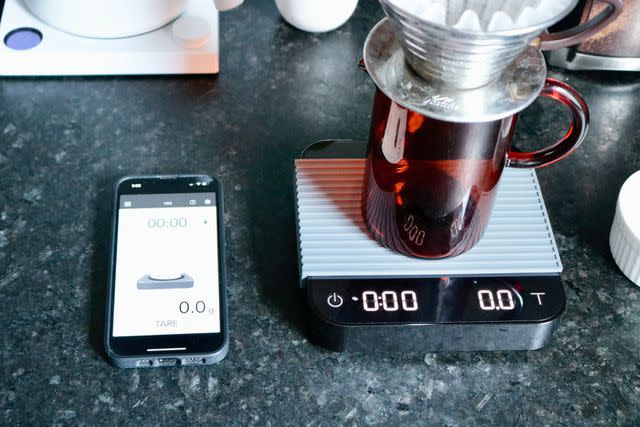
Serious Eats / Jesse Raub
Turns out: all of the scales were accurate enough for brewing.With all my testing for responsiveness and accuracy, the reality is that all of these scales would function well for weighing out coffee and measuring water during brewing. Any accuracy issues were within a few tenths of a gram, and scales with slow response times still read fast enough for brewing. With that said, the best coffee scales just feel great to brew with, and had responsive weight readings that matched pour speed perfectly, and with buttons that were easy to locate and press even while holding a gooseneck kettle full of hot water. They also look sleek and modern, adding a touch of visual appeal to your brewing ritual. The worst performing scales were fine, but being tested next to some knockouts made them look and feel clunky and less pleasant to use.
Bonus Functions Were Often More Confusing Than Helpful
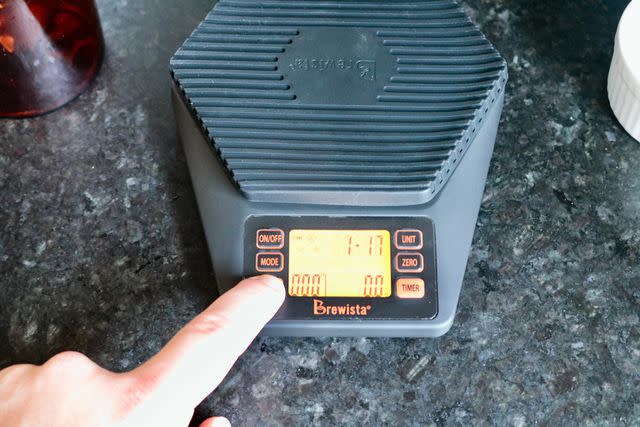
Serious Eats / Jesse Raub
Some of these scales, like the Brewista Ratio Scale, had extra functions and built-in brew guides, but we found these to be more confusing than helpful.A few of the scales offered bonus programming features designed to help people learn how to brew. Ultimately, these features were confusing. Auto-tare functions meant the scale would re-zero itself mid-pour, auto-ratio functions made it hard to decipher how much water you were adding at times, and step-by-step brew guide functions required reading detailed guides to understand how to use them. While some people might find these extras helpful, they required extra effort and knowledge to use properly, and added more work.
Heat-Proofing Matters
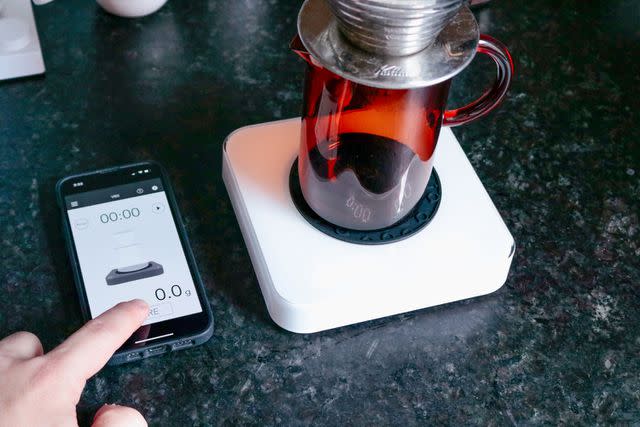
Serious Eats / Jesse Raub
All of the models tested had heat-proof silicone pads. Some of these were larger, some smaller—but every scale had one.A key addition to every coffee scale is the inclusion of a heat-proof silicone pad. Digital scales use a load cell to measure weight, which converts the amount of pressure applied to the platform into an electronic signal that a scale displays as a weight. The load cells use electronic resistance (the measure of an object in opposition to the flow of its electric current) to calculate these measurements, and electronic resistance can be extremely sensitive to heat. One test I originally planned to perform was seeing how sensitive a scale was to having hot water in a glass vessel directly on top of it, but further research showed this could cause permanent damage to the scales. So, I accepted that all scales are likely sensitive to temperature. And, indeed, all scales I tested came with a heat-proof silicone pad in the box.
Read More:Coffee Science: How to Make the Best Pourover Coffee at Home
The Criteria: What To Look for in a Coffee Scale
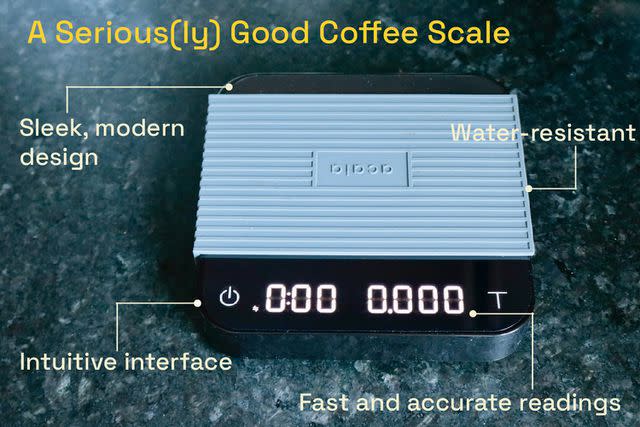
Serious Eats / Jesse Raub / Grace Kelly
The best coffee scales are fast, responsive, intuitive, and have an easy-to-read interface. They give accurate readings instantly without any measurable delay, showcase a design that is water-resistant, and have a simple timer function that helps make brewing easier. Our favorite pick has a flow rate indicator that aids in manual brewing methods, like pourover.
The Best Overall Coffee Scale: Acaia Pearl
Acaia Pearl

What we liked: The Acaia Pearl is lightning fast and accurate; it registered to .1 gram accuracy instantly, with no measurable delay. Other scales were off by .1 grams and took from a half-to a full- second to register. Its easy-to-read touchscreen is also extremely responsive, and has a few lights: one that shows you if the scale is charging, one that flashes to show a button has been activated, and a flow rate indicator that helps you gauge pouring speed. There is a line of dots across the top of the display that starts in the middle and moves outwards to showcase just how heavy your pour is. If you’re just learning how to brew a pourover at home, this indicator is an easy, intuitive function that can help you with basic timing and pacing.
Aside from all of the display features, the Acaia Pearl also has bluetooth connectivity with an easy-to-use timer and tare functions, as well as the ability to adjust units of measure, toggle sounds, and even check on software and firmware updates. The app pairing does more than give a secondary read out: it also makes it possible to use the scale to easily weigh items that are wider than the platform itself, similar to a feature we loved on our winning kitchen scale.
What we didn’t like: The main drawback for the Acaia Pearl is the price. At nearly three times the cost of the runner up, the Acaia Pearl is a luxury item, even if the functionality and features are, in my opinion, worth the cost. Then there’s also the issue of the scale’s display. With a minimal design, it’s not totally intuitive which buttons do what when trying to reset the timer, reset the tare, and switch modes. Even though the scale’s manual is clear and the app interface makes it easy to navigate, others scales were more intuitive out of the box. Still, it’s hard to ignore just how much better the scale performed and how much more accurate it was.
Price at time of publish: $150.
Key Specs
Size: 6.3 x 6.3 inches
Battery life: 30-40 hours
Precision: 0.1 grams
Maximum weight: 2000 grams
Measurement units: Grams, ounces
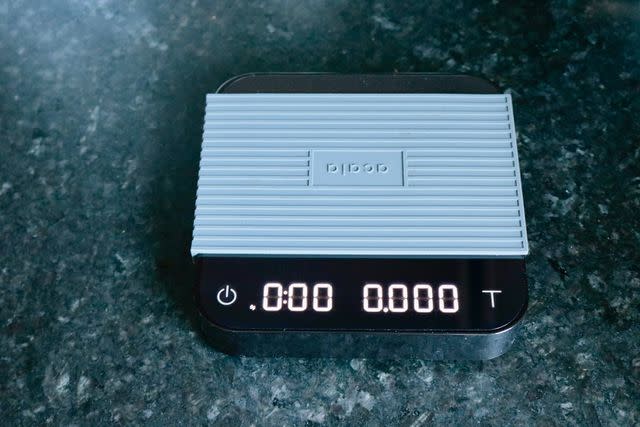
Serious Eats / Jessie Raub
The Best Budget-Friendly Coffee Scale: OXO BREW Precision Coffee Scale with Timer
OXO BREW Precision Scale with Timer

What we liked: The simplicity of the OXO made it a standout amongst the competition. While it wasn’t quite as responsive or accurate as some of the other scales during the coffee bean test, the OXO scale gave accurate water pour readings during brewing, and I appreciated its stripped down functionality and simple display. With a start/stop timer button on the left side of the scale, it was easy to control your timer while holding a kettle (at least, for right-handed people). We also liked the 3000-gram capacity which made it more useful for a wider variety of kitchen applications. Of all the scales tested, it was the most intuitive right out of the box and would be a great coffee scale for anyone looking to upgrade their set up at home.
What we didn’t like: The biggest downside of the OXO scale was its performance reading coffee weight. It generally took around one second to get an accurate reading, and even then it was generally off by .1 grams. It uses AAA batteries instead of a rechargeable internal battery, which might turn some people off from buying it.
Key Specs
Size: 5.5 x 7.5 inches
Batteries: Four AAA batteries
Precision: 0.1 grams
Maximum weight: 3000 grams
Measurement units: Grams, ounces
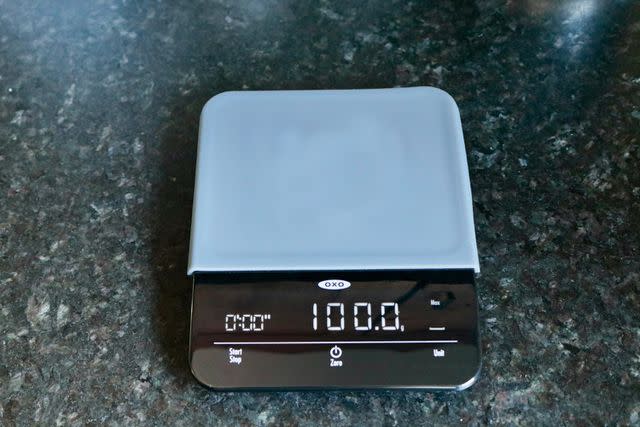
Serious Eats / Jesse Raub
The Competition
Acaia Pearl S: Hands down, the Acaia Pearl S was the most impressive scale for accuracy and responsiveness. It was the only scale that registered a single coffee bean, and the 3000-gram capacity made it stand out next to the Acaia Pearl. Ultimately, though, the higher price point and lack of flow meter on the display made it less appealing than the standard Pearl. The Pearl S also features Brewguide programming that walks you through custom recipes step by step, but this was a little too confusing. This is a pro-level scale, and would likely be more appreciated by a coffee professional.
Timemore Black Mirror: The Timemore Black Mirror performed admirably in accuracy and responsiveness testing, but the smaller display combined with a cheaper overall feel kept it from being competitive.
Hario V60 Scale: With a microscopic display and no backlighting, the Hario V60 scale was the hardest to read. It also didn’t even register any weight during the 10 bean test, calling into question its overall sensitivity levels.
Brewista Ratio Scale: The Brewista scale was a headache to use. With bonus ratio functions, a coffee mode and pouring mode, and unresponsive buttons, it was nearly impossible to use out of the box for simple weight and timer functions. It was also slow to read, and less accurate than most.
KitchenTour Coffee Scale: The slowest, most inaccurate, and cheapest scale of the bunch, the KitchenTour scale just didn’t match the quality of the other scales.
Escali Versi Coffee Scale: The Escali Versi was almost the runner-up. It was nearly as accurate as the Acaia scales weighing coffee, had quick response times, and had a great form factor. The Versi was too sensitive during brewing, however, and the weight read out would fluctuate during pours. The timer button is also located on the right side of the scale, making it awkward to start and stop the timer while brewing with a kettle for right-handed people, but ideal for those who are left-handed.
FAQs
Is a coffee scale worth it?
People who brew by hand every morning with a French press or a pourover brewer would likely find a more streamlined process with a coffee scale. The added heat-proof silicone mats, the built in timers, and the accuracy of a good coffee scale can make manual coffee brewing much more accurate and consistent.
Do I need to weigh my coffee?
Different coffee beans will have different densities, so a two-tablespoon scoop of one coffee will not be the same mass as a two tablespoon scoop of another coffee. Coffee is the roasted seed of a small berry and higher elevation coffees are usually denser than lower elevation coffees. Once the berries are picked, washed, and roasted, two coffee beans side-by-side might look identical, but if one has 10% more mass than the other, a volume-based scoop will not represent the same amount of coffee. Scales measure weight, and give a more accurate representation of the mass of each coffee.
How accurate does a coffee scale need to be?
Coffee should be weighed out in grams due to the small quantity of beans most manual brew methods use. Because many coffee recipes are designed as a ratio of the weight of coffee to the weight of the brew water, measuring in grams is more accurate than measuring in ounces. Most coffee ratios are one part coffee to sixteen parts water (1:16), and weighing both in grams can help with accuracy in brewing. The best coffee scales will show a .1 gram resolution so you know exactly how much coffee and water you’re using. It is also helpful to have .1 gram resolution when brewing one cup at a time, due to the smaller quantity of coffee being measured.
Should you use a scale for pourover coffee?
The best way to measure coffee is by weight, and it's also the best way to measure your water, too. When you put your entire pourover brewer on top of a scale, you can measure the exact amount of water you're adding to your coffee, and develop a more precise brewing recipe. With this kind of precision, you're able to develop your favorite coffee ratio into a regular recipe—we suggest starting with one part coffee to sixteen parts water (1:16), which is around 60 grams of coffee per liter of water.
Read More:We Tested 15 Pourover Coffee Makers—Here Are Our Favorites

